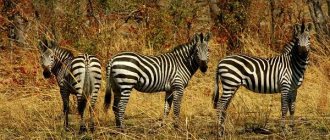Elephant: general characteristics
These animals belong to the class of herbivorous mammals, belong to the order Proboscidea and represent the elephant family.
Gray giants rightfully bear the title of the largest mammals on the planet. They have a massive elongated body, thick straight legs and a thin tail with a pubescent tip. Elephants reach a height of 2-5.5 m, and their weight ranges from 2 to 12 tons. The color of animals has all shades of gray, sometimes brown or brownish. In rare cases, albino elephants are found, and white giants are especially revered in Buddhist monasteries.
Elephants are an ancient and unique animal species
Elephants' skin is rough and dense, covered with thin folds and wrinkles. But although they are called pachyderms, these animals are very sensitive to ultraviolet radiation and insect bites, and to escape the heat and stinging flies, they often take water and mud baths. And in general, these giants are excellent swimmers and can easily cross a long, deep river.
Despite their impressive dimensions, elephants do not seem clumsy, but even move with grace and grace. And all because their step is almost silent, thanks to special fat pads on the inside of the foot, which gently cushion with every step.
One of the features of elephants that has become their curse is their long, sharp tusks, which are modified incisor teeth and grow throughout their lives. Interestingly, only males from the genus of African elephants have luxurious tusks; in females and Asian subspecies they are poorly developed or absent altogether.
But the main attribute of elephants, which has become their calling card, is their trunk. This elongated nose has one or two sensitive processes that serve as the animal's natural scanner. And also, with the help of a muscular appendage, elephants get food for themselves, drink, and even arrange a shower for themselves, taking water into their trunks and watering their bodies with such an improvised “hose.”
Elephants have poor eyesight, but they have an excellent sense of smell and excellent hearing. These giants also have high intelligence, they easily learn various tricks, are able to recognize themselves in the mirror, and have a keen ear for music. By the way, elephants love classical compositions most of all, they especially like the sounds of the piano and violin.
The average lifespan of elephants is 60-80 years. It is noteworthy that African elephants in captivity live less than in the wild, and Asian giants in zoos often get sick and do not live out their due dates due to the fact that they are fed too high-calorie foods and unhealthy sweets.
Elena
Ask a Question
Question to the expert
Why can't elephants jump?
These animals cannot jump because they need to rely on at least one limb to maintain balance, and all four legs are used when jumping. Scientists also believe that elephants do not jump because their legs are too weak to lift such a massive body into the air.
Description
- Unlike, for example, their savannah counterparts, these individuals are medium-sized and inferior to their own kind in size. They grow at the withers to about one and a half meters, which is very short for such animals. At the same time, African representatives grow to almost 4 meters. The weight category varies between 2.6-6 tons.
- The tusks are thin and elongated. Thanks to this structure, animals make their way through dense bushes and can exist calmly in tropical forest belts. The ears are huge and round in format. Animals hear perfectly well and are guided by this.
- The skin is not endowed with sweat glands in large numbers. Therefore, elephants, like other individuals from this family, use their ears to fan themselves and control their body temperature. Their jaws are long and narrowed.
- The front limbs have 5 toes, while the hind legs have only four. The trunk refers to a process formed by connecting the nose and upper lip. It is vital for collecting water, grabbing objects and other actions. With the help of the trunk, individuals communicate, hug their offspring and perceive the environment.
common elephant - description, habitat, lifestyle
Habitat
The natural habitat of elephants is limited to the African continent and a number of Asian countries. Regions of residence depend on the type of animal. Elephants from Africa have perfectly adapted to hot climatic conditions, and prefer to settle in arid savannas, flat areas and sparse forests, but they avoid deserts and impenetrable tropics.
But their Asian fellow tribesmen tolerate the scorching rays of the sun less well, and they prefer life in humid forests with lush tropical vegetation. Indian elephants generally feel best in inaccessible jungles, because trees and bushes serve them not only as a source of food, but also as a reliable refuge from predators and poachers.
Elephants inhabit the savannas of Africa and the humid tropics of Asia
Water plays a key role for all species of elephants, so gray giants always try to stay close to natural bodies of water, and love to splash in clean, cool rivers, warm lakes and even swampy puddles.
African elephants once lived throughout the continent, including the northern regions. But now their range extends from the central to the southern part of the continent, covering eastern and western Africa. Animals can be found in the wild in the following countries:
- Namibia;
- Tanzania;
- Chad;
- Mali;
- Ethiopia;
- Burkina Faso;
- Kenya;
- Zimbabwe;
- Democratic Republic of the Congo;
- Rwanda;
- Lesotho;
- Ghana;
- Gabon;
- Zambia;
- SOUTH AFRICA.
The Asian elephant ranges from east to west, including several southern countries and island states such as:
- India;
- Butane;
- Bangladesh;
- Nepal;
- Thailand;
- Cambodia;
- Laos;
- China;
- Burma;
- Malaysia;
- Sri Lanka (Ceylon);
- Sumatra Island;
- Borneo Island.
What types of elephants live on Earth and where
There are three species and three subspecies of animals in Africa and Asia.
African savannah elephant Loxodonta africana
Savanna elephant Loxodonta africana
This is the largest land animal. As the name suggests, elephants graze on the savannah, but some live in the Namib and Sahara deserts. African savanna elephants are light gray, large, and their tusks curve outward and upward.
Forest elephant (Loxodonta cyclotis)
Forest elephant Loxodonta cyclotis
It was considered a subspecies of the African savannah elephant, but was later classified as a separate species that arose 2-7 million years ago. These elephants are smaller, have more rounded ears, and their trunks are hairier than those of savannah elephants. The forest elephant is darker gray in color and the tusks are straighter and point downwards.
These elephants prefer dense forests, with most of them found in Gabon. They feed on fruit (leaves and bark making up the rest of the diet) and live in small, isolated groups of 2 to 8 members.
Indian elephant (Elephas maximus)
Indian elephant Elephas maximus
He has a large head and short and powerful neck and paws. They use their large ears to regulate their temperature and communicate with other elephants. Differences between Indian and African elephants:
These elephants have long tails that extend below their knees. Indian elephants rarely have tusks, and when they do, the tusks do not grow outside the mouth.
The Indian elephant is found in 10 countries in Southeast Asia, but the majority (about 30,000) live in four regions of India. These include the foothills of the Himalayas in the northeast and northwest, the central states of Orissa and Jharkhand, and the southern state of Karnataka.
Sri Lankan elephant (Elephas maximus maximus)
Sri Lankan elephant (Elephas maximus maximus)
The largest of the Asian subspecies. Sri Lanka houses an impressive number of elephants for such a small country. Research shows that Sri Lanka has the highest elephant density in Asia. They live in lowland arid zones in the north, east and southeast of the country.
The Sri Lankan elephant has characteristic unpigmented spots, which are areas of the skin without color on the ears, head, torso and belly. This elephant is the largest and at the same time the darkest of the subspecies of the Asian elephant. Differs from the African elephant in having smaller ears and a more curved spine. Unlike its African relatives, females of this species are tuskless. In females that have tusks, they are very small, almost invisible, visible only when the mouth is open. Males grow quite long tusks, which can be longer and heavier than those of African elephants.
Sumatran elephant (Elephas maximus sumatranus)
Sumatran elephant Elephas maximus sumatranus
Endangered. Over the past quarter century, 70% of the Indonesian island's elephant habitat (mostly canopy forests) has been destroyed, which does not bode well for population recovery.
Significantly smaller in size than African elephants. This subspecies reaches a maximum height of 3.2 m and weighs up to 4000 kg. Compared to Sri Lankan and Indian elephants, the Sumatra subspecies have lighter skin color and minimal signs of depigmentation on the body. Females are smaller and lighter than males and have shorter tusks that are barely noticeable. Compared to the tusks of other Asian subspecies, the tusks of Sumatran elephants are shorter.
Bornea elephant (Elephas maximus borneensis)
Bornea Elephant – Elephas maximus borneensis
Some zoologists consider island elephants to be a fourth distinct species, smaller than other Asian elephants. Borneo elephants have a long tail that reaches almost to the ground and straighter tusks. Their "baby" heads and more rounded body shape add to their attractiveness.
Males grow up to 2.5 meters in height. Their skin ranges from dark gray to brown.
What do elephants eat in the wild?
These animals have a completely vegetarian diet, and their menu consists of plant foods. Elephants' diet depends on their habitat, and they eat everything they can reach with their trunk. Giants feed on green grass, leaves of bushes and trees, young shoots and branches, and also eat tree bark. Elephants dig up edible roots and roots and love seeds, nuts and berries. They also enjoy eating fresh fruits from wild palm trees.
Elephants love green, lush greens.
Elephants are not averse to eating grains and vegetables, for which they visit nearby farmlands. The animals eat sugar cane, corn and wheat stalks, and their favorite treats are pumpkins and sweet potatoes.
Adult elephants require at least 300 kg of food per day, so they spend 12-15 hours a day searching for food. Proboscideans also need a lot of liquid, drinking about 200 liters of water per day.
Question to the expert
How do elephants drink water, with their mouth or trunk?
They first draw in water with their trunk (which holds up to 6 liters of liquid), then close it with a flexible tip, and then send the water into their mouth. By the way, at first young elephants drink with their mouths, like all animals, and only over time they learn to use their trunk for this purpose.
Listen to the voice of the African elephant
Elephants are in constant migration. When a herd travels a long distance, it can unite with other small herds into one large one. Elephants move due to droughts and lack of food.
In a rare occurrence, a mother elephant gave birth to twins.
The atmosphere in the herd is friendly. When in danger, elephants help each other out. They are very kind to their offspring. Skirmishes arise between females for leadership and between males for females.
The basis of the diet is plant foods. Every day an adult eats 450 kg of food, this process takes most of the day. These animals sleep standing up, the herd forms a circle, with their heads facing the center. Elephants have very poor vision and navigate by sounds and smells. They love to swim and are excellent swimmers. These animals are very clean.
The baby learns to prick up his ears and roar threateningly.
Lifestyle and behavioral characteristics
Unlike many animals of the African savannas and Asian jungles, which are active at night, elephants are diurnal. These giants do not have to fear attacks from enemies, so during daylight hours they constantly move from place to place in search of food.
And with the onset of dusk, the elephants go to bed for the night, posting several guards whose task is to notice in time the approach of predatory animals. The sentry shift lasts 4 hours, after which they are replaced by another group of sentries.
Huge and powerful elephants can afford a daily lifestyle
Members of the elephant clan huddle closely together at night, and the babies are placed between the adults. In this way, they protect elephant calves from hungry predators who can sneak up on the family under the cover of night and drag away the defenseless baby.
Interesting fact: Asian elephants sleep lying on their sides or stomachs, while their African relatives prefer to sleep in a standing position. Scientists explain this by saying that the soil in Africa gets hot every day under the scorching sun, and animals are simply afraid of overheating.
Elephant social structure
Gray giants live in small clans, numbering from 10 to 15 individuals. A real matriarchy reigns in the elephant community, and at the head of each group is a mature, experienced female. It is she who directs all the actions of the clan: she leads the herd to watering, finds new places for feeding and keeps order. The remaining members of the group are adult females, the younger generation and very young cubs.
Elephant family at a watering hole
There is complete love and mutual understanding in the elephant family. Everyone obeys the main elephant, and never tries to dislodge her from her leading position. When the leading female dies, the responsibility of head passes to her sister or daughter, and again, the change of power occurs peacefully, the clan unconditionally accepts the new leader, there are no offended or dissatisfied people in it.
Reproduction and raising of offspring
Elephants reach sexual maturity quite late, which is not surprising given their long life span. Females reach reproductive age at 12 years of age, although they become mothers for the first time at approximately 15-16 years of age. Males are ready to reproduce at 16-18, but they have to compete with more mature males, so they receive the right to their first mating no earlier than they turn 25-30 years old.
The reproduction of elephants is not tied to a specific season; they look for a mate at any time of the year, and here everything depends on the readiness of the females for the process of reproduction.
Features of the mating season of elephants
When the females go into heat, they separate from the herd and attract the attention of all the males in the area with their uterine sounds. Many gentlemen rush to respond to her call, having to win the favor of the gray lady in battles.
Males compete for the right to own a female
Males become very aggressive during the mating season, and this condition is called “must”. It is better not to approach elephants that have gone into heat, as they often attack other animals and even people.
Fights between males are rather ritualistic, and are intended to demonstrate strength and power, and not to harm the opponent. Excited suitors stand opposite each other in front of the chosen one, spread out their ears and trumpet loudly. If the size and voice of the contenders are equal, they begin to measure their strength, felling trees and throwing trunks to the side. Usually, this is enough for one of the males to admit defeat and concede. In very rare cases, it comes to a real fight, and then the elephants clutch their trunks and tusks, trying to knock their competitor to the ground.
The winning male secludes himself with the female for several days, courtes his partner and shows his love with affectionate touches. After intimate pleasures, the couple remains together for some time, arranging romantic walks and swimming together under the moon. The female then returns to her natal herd, and her gentleman goes off in the opposite direction, joining his bachelor clan.
Duration of pregnancy and childbirth
Elephants bear their offspring for 22-24 months, and their total gestation period is 2 years. Anticipating the approaching birth, the expectant mother leaves the group, but for support and help, one experienced mature female also goes with her.
Mother with newborn baby elephant
One baby elephant is born; very rarely there are twins in one litter. A newborn baby weighs about 60-110 kg, which rises to its feet 2-3 hours after birth. The female spends a few more days in the company of her mate and the cub, after which they return to their clan together. And the whole family joyfully welcomes the new mother and the tiny elephant clinging tightly to her tail.
FOREST BLOWERS
In dense, humid forest conditions, elephants, which have relatively poor eyesight, are forced to rely on their sense of smell and hearing. In dense undergrowth, elephants communicate using sounds that travel up to 8 km. There are about ten characteristic sounds; thus, fear, fright or anticipation of an attack is expressed by trumpet signals, and rage or excitement is expressed by guttural snorting. Sound communication plays a very important role when searching for a partner: since the female elephant is only capable of conceiving for a few days, the male must quickly determine her location.
Natural enemies of elephants
Adult elephants have no enemies among animals. Even lions and tigers do not consider huge and powerful elephants as potential prey. But there are more than enough young elephants and newborn elephants who want to attack. Leopards and Bengal tigers encroach on easy prey, although they themselves often die under the thick legs of giants protecting their offspring.
No one dares to challenge a herd of elephants
But lions and spotted hyenas hunt elephant calves with great success. These animals have a numerical advantage, because they drive the prey as a whole group, and often young proboscideans become their rightful trophy.
But the most terrible enemy of elephants is, of course, humans. For centuries, people have exterminated gigantic animals for the sake of valuable ivory. And even now, even being under the protection of government services, the gray giants cannot feel completely safe. Many poachers hunt elephants for easy money, because there is still a huge demand for their tusks on the black market.
PURE VEGETARIAN FOOD
Thanks to its purely vegetarian diet, the forest elephant has a significant impact on plant diversity, as it is the main disperser of seeds for at least a third of all large tree species.
Animals reach their favorite feeding places along a network of trails they themselves have laid. Elephants' search for food has a significant impact on the forest landscape. Herds of elephants maintain clearings and regularly dig grooves in the soil of the relict forest. These gaps attract other animals and give plants space and light to grow.
Due to the destruction and fragmentation of African rain forests, the long journeys typical of forest elephants in search of food sources have now become almost impossible. Therefore, animals increasingly damage the shrinking habitat by gnawing trees.











